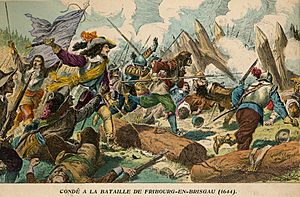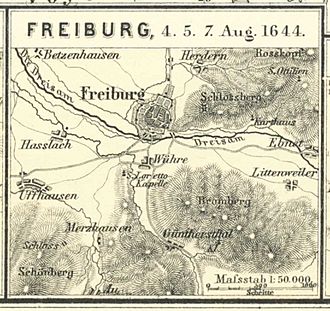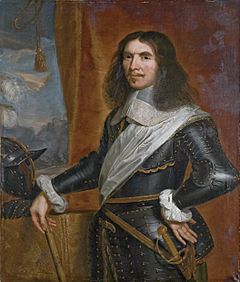Battle of Freiburg facts for kids
Quick facts for kids Battle of Freiburg |
|||||||
|---|---|---|---|---|---|---|---|
| Part of Thirty Years' War | |||||||
 Condé at Freiburg |
|||||||
|
|||||||
| Belligerents | |||||||
| Commanders and leaders | |||||||
| Strength | |||||||
| c. 16,000 | c. 13,000 | ||||||
| Casualties and losses | |||||||
| c. 8,000 | c. 4,000 | ||||||
The Battle of Freiburg was a series of fights that happened on August 3, 5, and 9, 1644. It was part of the Thirty Years' War, a big conflict that lasted from 1618 to 1648. The battle took place near Freiburg im Breisgau, which is now in Germany.
A French army of about 16,000 soldiers, led by Condé and Turenne, tried to take back the town of Freiburg. The town had just been captured by a Bavarian army led by Franz von Mercy. This battle was one of the bloodiest of the war. About half of the French soldiers were killed or hurt, and the Bavarians lost about a third of their men.
The French said they won because Mercy's army had to leave. However, some people still debate who truly won the battle.
After capturing Freiburg on July 28, Mercy set up his troops in strong defensive spots on the hills outside the town. The French attacked these positions on August 3 and 5. The French attacks didn't make much progress and they lost many soldiers. But the Bavarians also suffered heavy losses and were running out of supplies.
On August 9, Mercy found out that a part of the French army, led by Turenne, was trying to cut off his supply routes. So, Mercy ordered his army to retreat. He left a small group of soldiers to defend Freiburg. Even though they left behind their supplies and some cannons, the Bavarians managed to retreat in good order.
Even though the battle was very costly for the French, it convinced Maximilian I, Elector of Bavaria, that his side couldn't win the war. He started talking about peace. Mercy was told to stop attacking, which gave the French the advantage. Condé and Turenne were then able to take control of most of the northern Upper Rhine area.
Contents
What Led to the Battle?
In November 1642, the Swedish army won a big battle at Breitenfeld. This victory helped them control Northern Germany. In 1643, their French allies started attacking in the Rhineland.
On November 18, 1643, a French army captured Rottweil. They planned to use it as a base for the winter. But their commander, Guébriant, was badly wounded during the siege and later died. On November 24, his replacement, Josias von Rantzau, was surprised by a Bavarian and Imperial army at Tuttlingen. The French army of 16,000 soldiers was almost completely destroyed. More than two-thirds were killed, wounded, or captured.
Rantzau was captured, and Turenne took over. He quickly worked to rebuild the French army. The French situation became even harder when Sweden started a war with Denmark in December 1643. This meant fewer resources for the war in Germany. During the winter of 1643-1644, Mercy took control of many areas along the Upper Rhine and in Swabia.
For the summer of 1644, Maximilian I, Elector of Bavaria, wanted to push Turenne out of his bases on the Rhine. To do this, Mercy first captured Überlingen on Lake Constance on May 11. Then, he moved towards the French-held town of Freiburg. After some small fights with Turenne in the Black Forest, Mercy arrived outside Freiburg on June 16 and began to besiege the town.
Turenne, who had moved back to Breisach, was ordered to help Freiburg. He arrived on July 1 with about 8,000 men. By this time, the Bavarians had set up strong positions in the mountains at Schönberg and Lorettoberg. They also had small forts along the plain in front of the town. Turenne's first attack failed, so he stopped and asked for more soldiers from Cardinal Mazarin.
On August 2, 9,000 more soldiers arrived from Flanders, led by Condé. However, Freiburg had already surrendered on July 28. Since Condé was higher in rank than Turenne, he took overall command. He decided to attack the next day.
The Battle: August 3 and 5
The French leaders had long discussions about how to attack. They finally agreed that Condé would attack Mercy's defenses on the Schönberg hill. This hill blocked the main road into Freiburg. At the same time, Turenne would march around through Wittnau to attack the village of Merzhausen from behind. To make sure both attacks happened at the same time, Condé waited until 5:00 PM for Turenne to get into position.
Turenne started his attack as planned, even though the ground was difficult. But Mercy's extra soldiers pushed him back, and he couldn't get through. Meanwhile, Condé personally led the attack on the Schönberg, even though his officers protested. His men captured the positions after many hours of fighting, but they lost many soldiers. It was too dark to continue fighting after their success. Turenne had finally started moving forward again, but many of his men were still catching up because of heavy rain. At midnight, both commanders decided to stop fighting.
Mercy used this break to move his troops to new positions at the Lorettoberg hill. By driving the Bavarian forces off the Schönberg, Condé and Turenne could bring their armies together at Merzhausen, about five kilometers outside Freiburg. However, they still faced strong defensive walls. Also, it rained constantly, so no fighting was possible on August 4.
The French commanders decided that their only other choice was to retreat. So, on August 5, they chose to attack the defenses along the Lorettoberg and at Wiehre head-on. These attacks turned into messy and bloody fights that lasted most of the day. When night came, Mercy still held his ground. But two days of fighting had reduced his army by a third, while the French had lost half of their soldiers.
The Battle: August 9
The French spent the next three days moving their wounded soldiers to Breisach. They also gathered 5,000 new soldiers from nearby forts for their next attack. Condé stayed in Merzhausen to keep Mercy busy. Early on August 9, Turenne took 6,000 men and started marching behind Mercy's army towards Denzlingen. This town was five kilometers north of Freiburg. The French hoped this would cut off Mercy's escape route to Villingen, forcing him to fight or run away quickly.
However, Mercy had already decided to retreat. Two days of battle had left him with only about 6,000 men. They were also running low on ammunition and food. This was especially a problem for his cavalry (soldiers on horseback), who were important for covering the retreat. Their horses were not getting enough food, so they were becoming weaker.
Mercy left a small, chosen group of soldiers to hold Freiburg. On August 9, the rest of his army began to retreat towards St. Peter. This town controlled the road to Villingen. On the morning of August 10, Turenne's cavalry caught up with the Bavarian rearguard (the soldiers protecting the back of the retreating army) just outside St. Peter. This forced the Bavarians to leave behind some cannons and supplies. But the retreat continued in good order, and Mercy reached Rottenburg am Neckar on August 15 without further problems.
The total number of soldiers lost during the three days of battle was huge for both sides. Some say the French lost about 50% of their men, or 8,000 soldiers. The Bavarians lost about a third, or 3,000 soldiers. Other estimates for French losses range from 5,000 to 8,000, and for Bavarians from 2,500 to 6,800.
At the time, the French claimed victory because Mercy's retreat meant they were left in control of the battlefield. Many historians agree with this view. However, others think it could also be seen as a draw, or even a tactical victory for the Bavarians. They fought off the French attacks and caused many losses.
What Happened After?
Mercy still controlled most of Swabia, but his losses made Maximilian forbid any more attacks. Mercy's retreat to Rottenburg also left the Upper Rhine area open to the French. Turenne convinced Condé not to spend the rest of the summer trying to retake Freiburg. Instead, they marched north to capture Philippsburg, which surrendered on September 12. After this, the French went on to take Worms, Oppenheim, Mainz, and Landau. This left them in control of the Rhine valley.
Maximilian was now sure that the war could not be won. He pressured Emperor Ferdinand to start peace talks again. These talks began in November 1644, but fighting continued as both sides tried to get a better position for the negotiations. Many experienced Bavarian cavalry soldiers were lost at Jankau in March 1645. In May, Mercy destroyed a French group at Herbsthausen. But then, he was defeated and killed at Second Nördlingen in August. This was a big loss for Maximilian, as Mercy was his most effective military commander.
Images for kids








